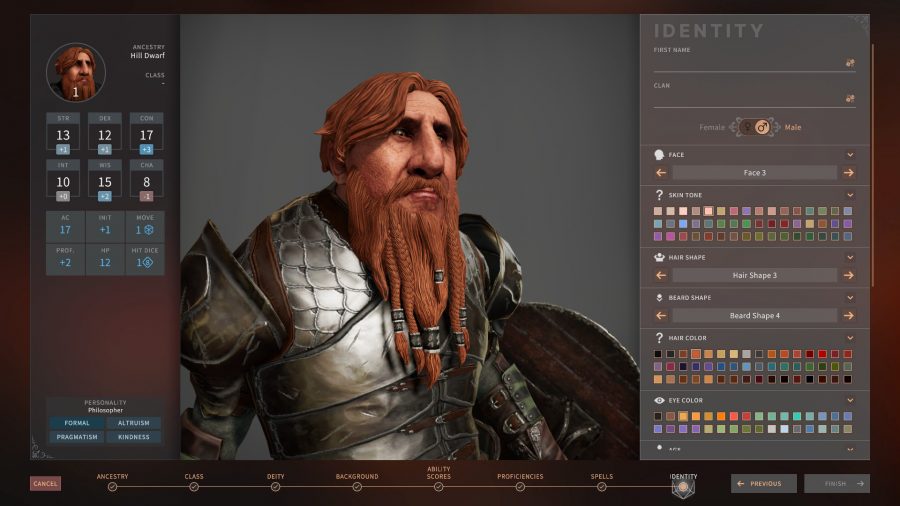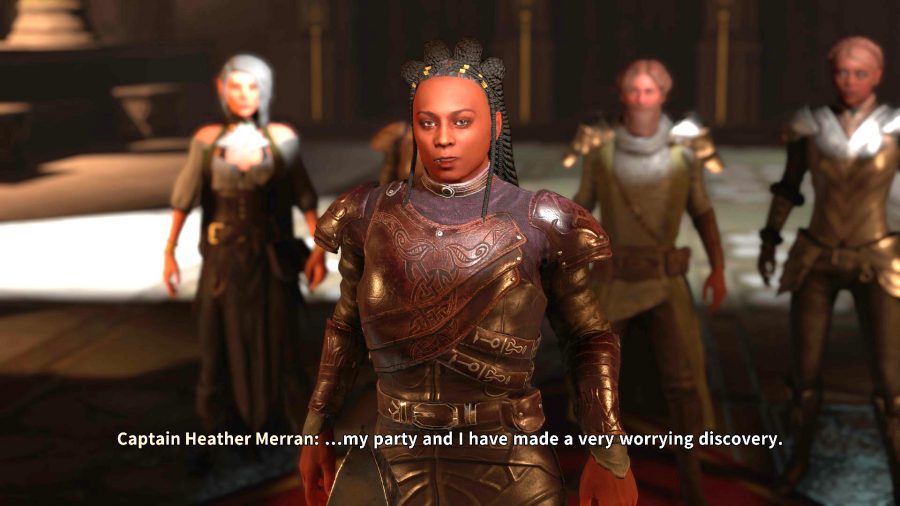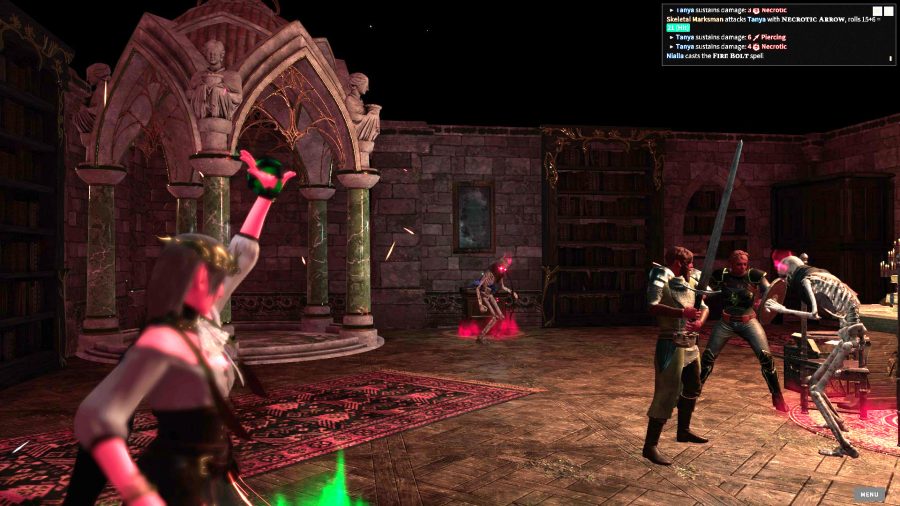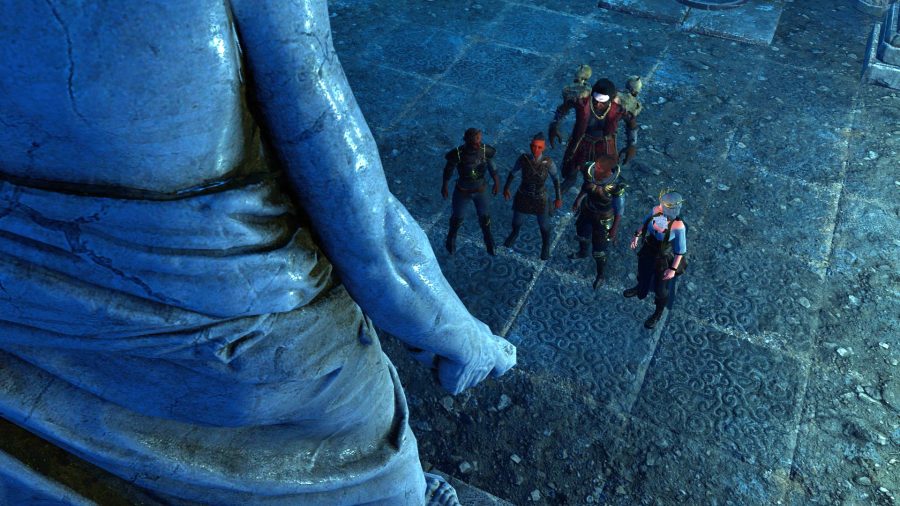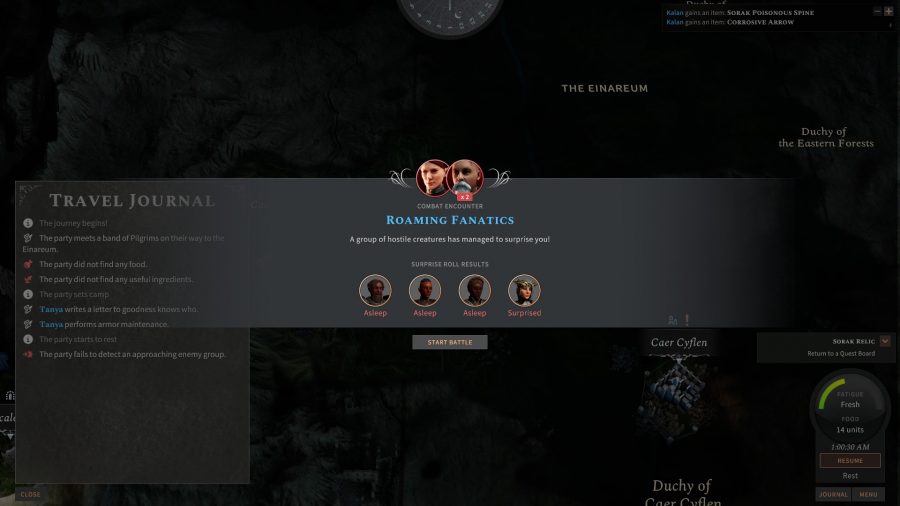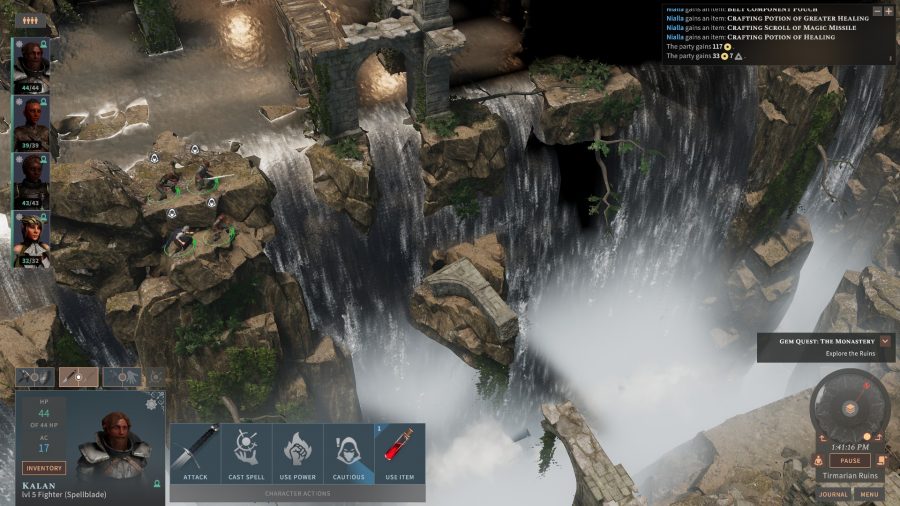Timestamped for your convenience.Stealing a Wizard's spellbook is pretty standard practice since 1st ed but became infinitely more popular in 3rd ed.
-
Welcome to rpgcodex.net, a site dedicated to discussing computer based role-playing games in a free and open fashion. We're less strict than other forums, but please refer to the rules.
"This message is awaiting moderator approval": All new users must pass through our moderation queue before they will be able to post normally. Until your account has "passed" your posts will only be visible to yourself (and moderators) until they are approved. Give us a week to get around to approving / deleting / ignoring your mundane opinion on crap before hassling us about it. Once you have passed the moderation period (think of it as a test), you will be able to post normally, just like all the other retards.
You are using an out of date browser. It may not display this or other websites correctly.
You should upgrade or use an alternative browser.
You should upgrade or use an alternative browser.
KickStarter Solasta Pre-Release Thread [GAME RELEASED, GO TO NEW THREAD]
- Thread starter Safav Hamon
- Start date
Mortmal
Arcane
- Joined
- Jun 15, 2009
- Messages
- 9,656
No need to wait, hardly any bugs, people are vastly exagerrating. If i finished it, means its playable with the luck i have i'd encounter every worse bugs possible by now.So what's the verdict? I've seen a lot of the Kickstarter backers who had access to the full version talk about bugs and roadblocks. Should I just wait a couple of weeks for a post-launch patch?
Inspectah
Augur
- Joined
- Jun 29, 2015
- Messages
- 468
Yup, so far the only real bug (not counting stupid shit like Beard clipping) is that sometimes my dudes would climb on Air instead of on a block or ledge, but the end result was the same so whateverNo need to wait, hardly any bugs, people are vastly exagerrating. If i finished it, means its playable with the luck i have i'd encounter every worse bugs possible by now.So what's the verdict? I've seen a lot of the Kickstarter backers who had access to the full version talk about bugs and roadblocks. Should I just wait a couple of weeks for a post-launch patch?
- Joined
- Jan 19, 2014
- Messages
- 14,592







AHA! You could not make a fool of me this time, game. I had a splendid armor in my inventory. After the fiasco with the magnificent item that I sold, I got very suspicious. I've got my eyes on you game, I've got my eyes on you...

Time for some identification. Ah. as I suspected, it is a half plate +1, which fits perfectly on my muscular dwarf. Game, today I was not a fool. Today was a good day.

Time for some identification. Ah. as I suspected, it is a half plate +1, which fits perfectly on my muscular dwarf. Game, today I was not a fool. Today was a good day.
Sorry (or not?) for being cheesy. Game puts me in a good mood.
Last edited:
lycanwarrior
Scholar
- Joined
- Jan 1, 2021
- Messages
- 1,523
New review from Wccftech:
https://wccftech.com/review/solasta-crown-of-the-magister-tactics-dragons/
"Solasta: Crown of the Magister is as solid as any cRPG can get, possibly even more than most, but it's definitely not a game for everyone."
https://wccftech.com/review/solasta-crown-of-the-magister-tactics-dragons/
Solasta: Crown of the Magister Review – Tactics & Dragons
Role-playing games have been a thing for a very long time, way before gaming systems had the power to run a decent digital adaptation of any of them, but it's only been in relatively recent times that developers managed to create proper Dungeons & Dragons inspired video gaming experiences. Following the release of the original Baldur's Gate, many developers tried to create the perfect adaptation of the iconic tabletop role-playing game with varying degrees of success. Yet not many of these games manage to be as faithful to the Dungeons & Dragons ruleset as Solasta: Crown of the Magister, whose faithfulness is both its strongest aspect and biggest flaw.
Developer Tactical Adventures never tried to hide their intention of creating an almost perfect adaptation of the D&D 5e ruleset, and it shows right from the very beginning of the game. From character creation to mechanics, playing Solasta: Crown of the Magister is the closest you will get to play D&D without real people.
The game starts like any real D&D campaign would: in a tavern, where four different adventurers meet for the first time, attracted by the prospect of riches and glory or just for the excitement that comes from a new adventure. After a relatively short intro section, where players are taught the very basics of movement and combat, the real adventure starts, as the party sets out from the town of Caer Cyflen to investigate some mysterious happenings that may endanger the town, not knowing they will have to deal with all sorts of hellish creatures in their 40 plus hours long quest.
Right from the start, it's clear how Solasta: Crown of the Magister's story is not the game's best feature. The plot is rather predictable, and it really doesn't stray too far from fantasy tropes, featuring the usual assortment of characters and creatures we have seen in countless other RPGs. It's a shame that the story plays it so safe, as some of the lore behind the world of Solasta is quite interesting, as it actually reverses a trope we have experienced in The Witcher saga and a few other franchises: in Solasta, it's the humans that have invaded the world following a magical cataclysm, and not the other way around. Too bad this isn't further explored in any meaningful way during the course of the adventure.
This isn't to say that Solasta: Crown of the Magister doesn't try to do something new. Unlike most other cRPGs out there, the player can create their party of four adventurers from scratch before beginning the adventure or pick between a few pre-made characters. All party members are essentially the main character, as they get equal saying in the dialogue system, and they always take an active part in the story.
Character creation is definitely one of the game's standout features. While the visual customization options are somewhat limited, and most do not look great at all, the mechanical customization is incredibly deep. Together with picking the characters' races and classes, which are a pretty much 1:1 rendition of the D&D 5e races and classes, players can also pick the characters' moral alignments and traits based on these alignments, which influence the dialogue options that become available at certain points. It's not a massive game-changer, to be honest, but it does add a little bit of replay value, as it lets players experiment even outside of combat.
Solasta: Crown of the Magister's combat system is definitely the game's highlight and can potentially give a run for their money to many popular RPGs based powered by the D&D ruleset. Unlike most other RPGs out there, which employ a classic real-time combat system, Solasta: Crown of the Magister uses a turn-based, tactical combat system where players and AI enemies take turns moving around the battlefield, use weapons and items, unleash spells, and take advantage of the environment. While this combat system doesn't do anything differently from other similar systems, the almost perfect adaptation of the D&D classes and their combat capabilities, and the great map design, with tons of verticality, make Solasta: Crown of the Magister an incredibly fun game to play.
Things, however, may take some time to get going. Due to its faithful adaptation of the D&D 5e ruleset, it can be quite hard for newbies to understand everything with the in-game tutorials shown every time some new mechanic is encountered for the first time. The game does feature a digital rule book that provides a thorough yet easy to understand explanation of pretty much every mechanics, but if you have never played D&D before, you will feel overwhelmed at the beginning, being unfamiliar with the countless magic spells and special powers of each class. Thankfully, Solasta: Crown of the Magister features a very good difficulty system that lets the player tweak a lot of different elements, like removing critical hits and so on, so that even D&D newbies can learn the mechanics at their own pace without getting obliterated every single fight.
While the party system would have lent itself to a great multiplayer experience, Solasta: Crown of the Magister doesn't feature any co-op. However, it does feature a way for players to share their own experiences in the game via the Dungeon Maker. This in-game tool is a potent yet simple to use map creator that lets players come up with their own dungeons. Some of the creations made in the Early Access period are incredibly interesting, so it will be nice to see what players will be able to come up with the 1.0 release.
Having been developed by a small team, Solasta: Crown of the Magister doesn't feature a big-budget presentation. The character models look extremely simple, and so do most of the locations, which do not stray too far from the usual fantasy selection of abandoned forts, caves, dungeons, volcanoes, etc. As a side-effect, this means that most players with a relatively recent machine will not have troubles running the game decently at fairly high settings. The PC used for the test, powered by an i7-10700 CPU, RTX 3070 GPU, and 16GB RAM had obviously no trouble running the game at 4K resolution, 60 FPS with all maxed settings. One thing to note is that the game loads very slowly on mechanical hard drives, so installing the game onto an SSD is very recommended.
The strict adherence to the D&D 5e ruleset is both Solasta: Crown of the Magister's greatest asset and greatest flaw. While D&D fanatics will love every second of the game, despite some issues here and there, mostly caused by the vertical design of most combat maps that seems to force certain ranged attacks, magic-focused playstyle, those who are not into the tabletop RPG will find the game somewhat stiff, trapped in this ruleset that has been so faithfully adapted. Solasta: Crown of the Magister is as solid as any cRPG can get, possibly even more than most, but it's definitely not a game for everyone.
Review code provided by the publisher.
7.5
With its extremely faithful rendition of the Dungeons & Dragons 5e ruleset, Solasta: Crown of the Magister is a dream come true for all those D&D fans who also happen to love video games. However, strict adherence to this ruleset is also the game's main flaw, as it results in an overwhelming experience for all those who do not live and breathe Dungeons & Dragons. Those who power through the initial difficulties, though, will find a solid cRPG featuring great tactical combat and amazing depth.
Pros
Cons
- Extremely faithful adaptation of the Dungeons & Dragons 5e ruleset
- Interesting character creation options
- Solid tactical combat system
- Excellent map design
- Deep Dungeon Maker
- Uninspired story and characters, despite some interesting lore
- Vertical map design seems to favor certain party compositions and fighting styles
- Due to the strict adherence to the D&D 5e ruleset, the game can feel very overwhelming for newbies
"Solasta: Crown of the Magister is as solid as any cRPG can get, possibly even more than most, but it's definitely not a game for everyone."
Last edited by a moderator:
New review from Wccftech:
https://wccftech.com/review/solasta-crown-of-the-magister-tactics-dragons/
"Solasta: Crown of the Magister is as solid as any cRPG can get, possibly even more than most, but it's definitely not a game for everyone."


How can one of the simplest RPG systems ever made feel overwhelming? D&D 5th edition is barely more complex than fucking Dungeon Siege 3.
After the fiasco with the magnificent item that I sold, I got very suspicious
What do you mean by this? I read your earlier posts about it but didn't fully understand.
Darth Canoli
Arcane
Timestamped for your convenience.
That "practice makes perfect" was stolen from somewhere, i'm not sure if it's Wiz 8 or somewhere in Might & Magic...
Last edited:
AHA! You could not make a fool of me this time, game. I had a splendid armor in my inventory. After the fiasco with the magnificent item that I sold, I got very suspicious. I've got my eyes on you game, I've got my eyes on you...

Time for some identification. Ah. as I suspected, it is a half plate +1, which fits perfectly on my muscular dwarf. Game, today I was not a fool. Today was a good day.
Sorry (or not?) for being cheesy. Game puts me in a good mood.
Fine fine, you got me.
Someone who curates the upcoming rpgs list can't have trash taste.

I'll try to not compare it to the ideal of a 5e game in my mind this time but take it for what it is...
- Joined
- Jan 19, 2014
- Messages
- 14,592







I had a magnificent armor and weapon, or if it was both. These items show no bonuses in their numbers. Take the armor for example. It was a magnificent leather armor. I quickly skimmed the numbers, and it looked like a regular armor. When I sold it, I saw that I had gotten way more money than I should. So, I had another magnificent leather armor... This is getting awkward, I told myself. I should have identified that, oops!After the fiasco with the magnificent item that I sold, I got very suspicious
What do you mean by this? I read your earlier posts about it but didn't fully understand.
In other words magnificent and splendid items should be identified by your mage, because they are so far +1 items. In shorter words, they are unidentified items. I was thrown off, because when you get potions, it says unidentified potion.
- Joined
- Sep 5, 2017
- Messages
- 1,529

Not to sound vain... but have anyone found my shield yet?Time for some identification.
- Joined
- Jan 28, 2011
- Messages
- 100,774















Oh, there are reviews are there?
https://www.pcgamesn.com/solasta-crown-of-the-magister/review
https://www.pcgamesn.com/solasta-crown-of-the-magister/review
Solasta: Crown of the Magister review – DnD with a dash of XCOM
Swords, sorcery, and Solasta
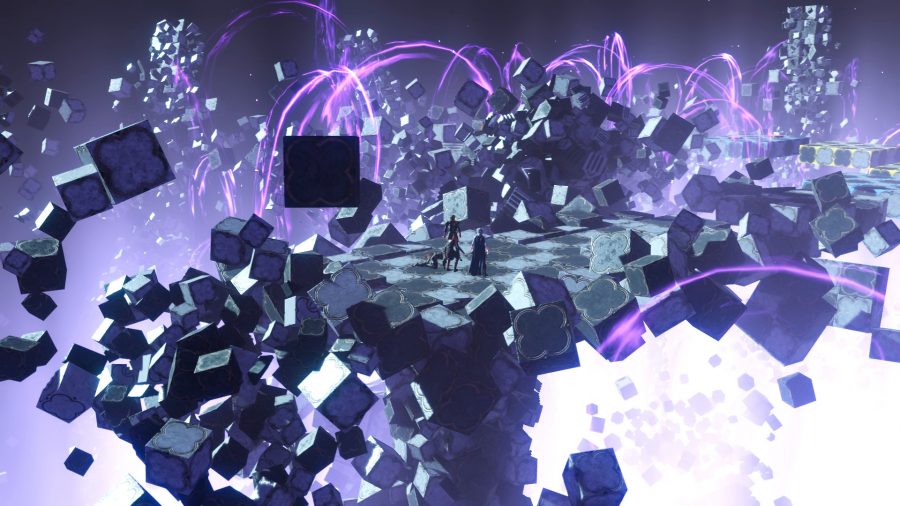
Solasta: Crown of the Magister stands stoically at the cross section of several game worlds. From a distance, the isometric RPG dungeon diving evokes old Infinity Engine games like Baldur’s Gate. Combat scenarios play out like an XCOM skirmish with a few more bells and whistles. Character moments and conversations remind me of Dungeons and Dragons, complete with stat checks and dice rolls. And yet, perhaps surprisingly, Solasta feels more like a tactical RPG than a DnD alternative, but is a delightful package nonetheless.
Every grand fantasy adventure starts in a tavern, and Solasta is no different. Your party of loose acquaintances meet under the same auspicious orders, sharing tales of the near death experiences they went through to get to their cups of ale. These characters can either be selected from the prepared roster, or created from scratch.
Cosmetic customisation options are limited compared to the more robust facial and body sliders you see in contemporary RPG games. You’re largely restricted to the same set of faces and hairstyles for everyone, with some race-exclusive features like braided beards for dwarves. Without adding some age to the characters though, their faces seem textureless and alien. It’s not a deal breaker that my half-elf ranger looks a bit like a procedurally generated NPC, but it is disappointing, especially next to the premade high elf wizard, who looks great.
Statistical customisation for characters, however, is wonderfully robust. The six available classes all come from fifth edition DnD, complete with dynamic variables that enable you to build in a little divergence.
Want a Ranger that can go toe to toe with the best fighter in a brawl? How about a fighter who can cast spells to supplement your physical damage? All are possible, and feel rewarding as you level up.
You can also assign personalities and backgrounds to characters in your party. The personality options let you drill down into behaviours, tagging them with traits like egoism or pragmatism. These spice up dialogues, but there don’t seem to be any ramifications for having a party with traits all over the alignment spectrum – they can still solve dialogue problems with normal skill checks. Backgrounds are another form of window dressing, mainly serving as triggers for character-specific side quests.
The world of Solasta is a curious one. A great cataclysm destroyed the old world a millennium ago, leaving vast swaths of the land blighted by powerful magic. The few communities that have rebuilt live cautiously, knowing that whatever is in the Badlands will find its way out eventually. Solasta doesn’t do much with this premise, however – many of its settlements are uninspired hubs for shops and quests, with little to make them stand out.
Thankfully the dungeons are a lot more striking, and you can expect to battle through necromancers’ towers tucked away in swamps, or to trudge through thicketed wastelands of lava floes and dark woodland. Even simple backdrops like cliff faces and waterfalls are used well, and make the land feel rugged and diverse.
Once your adventure gets underway, the 40-hour main story is pretty standard fantasy fare. Your quest has you traveling through both civilised regions and badlands alike in search of the pieces of a great artifact – the titular Crown of the Magister – that could prevent a second cataclysm. Along the way you’ll meet new people and travel to exotic locations, but almost every branch of this story tree ends in a fight.
That’s not necessarily a problem because the combat in Solasta is very good. Every turn, your characters can move across the grid-based maps and swing a weapon, cast a spell, or use an item. Most classes also get unique actions – the Ranger can mark a target so they do more damage to it. DnD players will recognise this system and fall in line, while newcomers shouldn’t find it much of a challenge. Fifth edition was designed to be simple to understand and execute, and this accessibility is in evidence every time the battle music starts.
Solasta complicates this with the makeup of its encounters and battle maps. On standard difficulty, enemies are tough and will capitalise on any opportunity you present. They don’t just hit the first person they see – they’ll look for priority targets, like those with low armour or who appear to be buffing or healing other party members. They’ll gang up on isolated characters and knock allies down to make them easier to hit.
If you’re standing next to a sheer drop, they will push you off the ledge. Depending on what you’re up against, they can fly or run up walls, all to get the right angle to defeat you. As you and your enemies get stronger, it becomes more and more important to use all your tricks to gain whatever advantages you can.
Excitingly, you can tweak the difficulty in granular ways. Comfortable with the damage enemies are doing to you, but think they have too much health? Just lower the enemy health multiplier. You can even add a blanket negative or positive modifier to all rolls for enemies and allies – I chose the karmic dice option, which only lets you roll poorly so many times before you automatically get a good roll. This did wonders for my blood pressure in later quests.
Between battles, you’ll explore environments for loot and clues to advance quests. Characters’ skills, like insight and lockpicking, help a lot in these scenarios, uncovering helpful lore about the ancient ruins you’re plundering, or unlocking navigation options like spelunking or breaking into locked doors. The character with the highest stat will make the rolls, but there’s no way to increase these stats after character creation. So if you have one persuasive person in your party, get ready to rely on them for all your sweet-talking needs.
Sadly, most of the loot you find is rarely more interesting than a piece of gear or a crafting recipe, and after a while, the risk of getting attacked while straying too far off the beaten path outweighs the reward of a new bauble.
I tried a few early-game scenarios with a variety of party compositions to see how necessary certain specialisations are to getting varied outcomes. Would my party still be able to identify the statue of an old wizard without a magic user present? Turns out they’d give it a shot, but be far less likely to succeed. I like the importance of party comp for making the most out of these scenarios, but I wish there was a reliable or creative way to fill in these exploratory gaps as you go along.
Between quests, you hop back to the hub city of Caer Ceflyn to restock on items and touch base with the various factions looking to buy whatever oddities you find out in the wild. This works like any faction system – the more you sell to one group, the more they like you, and thus you gain access to more of their inventory.
The quirky Scavengers are my favourite. Instead of buying curios from my party, they would go into dungeons and encounters after I leave, take all the trash loot I didn’t want or have space for, and give me a cut of what they earned after processing it all. Anything that removes the incentive to fill my bags with trash just to make some extra money, which is all to common in RPGs, is a good change in my book.
Solasta’s storytelling is hit and miss. The overall plot is serviceable at best, but occasionally you’ll run into a character or situation that makes the next hour or so truly memorable. There’s a great early dungeon where you meet several different characters who all live in the same fortress and serve the same master, but hate each other. Probing for an introduction to their master without stepping on too many toes or getting involved in their drama was a surprise delight.
But just as often there are simple fetch quests given by boring NPCs, which lead to repetitive encounters. Other times, an interesting quest can get hobbled by your own decisions. During the mid-game stretch, I was given a task to unite several clans of orcs against one emerging tyrant. This means I have to help each clan leader with a task, with the promise of their allegiance when I complete it.
I find a shortcut that lets me try to kill the tyrant without uniting the clans, and to my shock it works! But the story doesn’t seem to accommodate that ending at all. Not only does the orc companion who’s promised to help fight the tyrant just disappear without any trace or acknowledgement from the party, but they suddenly treat our new friends like completely disposable fodder in a way that wasn’t consistent with the hours we’d just spent talking to these people and learning their ways.
The automated, trait-based dialogue also occasionally steps over decent plot points. When there are multiple questions you can ask a subject, your characters will sometimes patch in responses to the wrong questions. I’ve seen them start one line of conversation, immediately switch to another, and then go back to the first, which can turn an emotional scene into a jarring one. It’s a cool idea, but the execution of this procedurally generated personality system is rocky.
Bugs also persist throughout Solasta. Dice rolls will sometimes not appear on screen, but a running log in the top right corner keeps track of all that as a backup. Combat AI sometimes breaks, making monsters meander in circles as they figure out what to do. And instead of crafting one magical breastplate that was supposed to take 12 in-game hours to complete, I ended up crafting one magical breastplate every hour for 12 hours. Silly and frustrating, but not game breaking.
It isn’t the final, polished product I hoped for, but Solasta: Crown of the Magister is a distinctive entry in the tactical RPG space. Though most of the the story and dialogue covers well-trodden territory, the combat is challenging and rewarding – even when it feels like the dice have a vendetta against you.
Solasta: Crown of the Magister review
Solasta’s tactical battles shine brightly, even in the shadow of a drab and by-the-numbers fantasy story.
7
Last edited:
Mortmal
Arcane
- Joined
- Jun 15, 2009
- Messages
- 9,656
New review from Wccftech:
https://wccftech.com/review/solasta-crown-of-the-magister-tactics-dragons/
"Solasta: Crown of the Magister is as solid as any cRPG can get, possibly even more than most, but it's definitely not a game for everyone."

How can one of the simplest RPG systems ever made feel overwhelming? D&D 5th edition is barely more complex than fucking Dungeon Siege 3.
People are mostly playing phones games giving them instant gratification now, so of course 5E is overwhelming for such people. The average guy is completely retarded .
To someone who likes rpg, that's worth 9/10 , pretty sure it will be 7/10 all over the board cause of far too small marketing budget, they arent giving bribes. BG3 will be 9-10 all over , be sure of it.
V_K
Arcane
Possibly. I had a couple of unique shields. Is it the one shaped like a cog or the one with light spells?Not to sound vain... but have anyone found my shield yet?
Darth Canoli
Arcane
A black woman with dreadlocks in armor...
So it's not Heroic Fantasy anymore, it's just Fantasy? Or science fiction?
You need to calm down. She's in the game for literally 30s, as she delivers exposition. I doubt you'll remember her name 30s after she's gone.A black woman with dreadlocks in armor...
So it's not Heroic Fantasy anymore, it's just Fantasy? Or science fiction?
Lacrymas
Arcane
- Joined
- Sep 23, 2015
- Messages
- 19,162

The reviewer betrays himself as never having played or read the rules of 5E from the title. Impressive speed. It usually takes a few sentences in the review itself.Solasta: Crown of the Magister review – DnD with a dash of XCOM
Also -
Character moments and conversations remind me of Dungeons and Dragons
???
- Joined
- Jan 28, 2011
- Messages
- 100,774















https://venturebeat.com/2021/05/26/solasta-crown-of-the-magister-review-tactical-success/
Solasta: Crown of the Magister review — Tactical success

See this crown? It's important to Solasta: Crown of the Magister. It's even in the name, dude!
One of my favorite encounters in Solasta: Crown of the Magister takes place early on in the first act. You’re in an underground ruin, and the candles, magic, and torches you’ve brought with you are the only light you have. The room has several gaps and levels, and the lizardfolk-like Sorr-akkath (or Soraks for short) are trying to kill you to keep their existence a secret from the world.
These Soraks are children’s nightmares come to life, a plague from the past before a cataclysm ripped apart Solasta. And they take advantage of terrain better than most monsters in RPGs, crawling on surfaces and walls in order to gain a modicum of cover from missile weapons and spells. This helps them stay in the dark as well.
What’s fantastic (and challenging) about this encounter isn’t just that you have to provide enough light to overcome the negative modifiers of fighting in the dark, while at the same time keeping your party close enough together to withstand the Soraks’ onslaught. You have chasms, too.
And you can use them to your advantage. And I did, pushing two of the menacing lizardfolk to their deaths thanks to some helpful positioning and what I consider clever use of magic.
This is where Solasta: Crown of the Magister shines. It might have the best moment-to-moment tactical gameplay of any party-based RPG out there. Every move matters, and you have to take light and terrain into account as well as the normal advantages and disadvantages you get in games using rules like Dungeons & Dragons‘ 5th Edition. Solasta leaves Steam Early Access on May 27 on PC, becoming indie studio Tactical Adventures‘ first released game.
Advanced tactics
I’ve already crowed about Solasta’s combat. You won’t find yourself tempted to jam through encounters as you might in other RPGs, otherwise, you’ll often be dead. Early on, even random encounters with thugs on the trail can be challenging and deadly.
Others may not appreciate this, as some encounters require a level of concentration you won’t find in other games. It can be a bit taxing, and that’s my only compliant about combat.
Even surprise encounters in camp while resting feature terrain with high and low points. Others, like inside a darkened keep or a cavern, have sconces and other hardpoints you can use for anchoring light spells and removing disadvantage that comes from not being able to see in low light. Finding a perch for your archers and spellslingers works on a couple of levels — they get better range and some protection for being higher up from melee scrums. If they have another character with them, those can push away threats, doing some extra damage and providing some breathing room for your casters and missile specialists.

Above: If it’s dark, try lighting up some of the terrain, like sconces and stalactites.
The Z-axis applies to exploration as well. Some levels play with gravity, and you’ll find yourself scampering up and down many rooms and areas. Exploring a ruined library requires taking advantage of reverse gravity to open pathways. It’s exciting to see all of this in an isometric RPG.
Tactics go beyond just how you position your wizards and warriors and balancing light levels. You have a party of four characters, and when creating your builds, it’s important to consider how those abilities and feats you take mesh with everyone else.
One example is in how I first built my ranger and rogue to be a bit too similar, both focusing on ranged attacks. This left my cleric as my go-to melee brawler, and oftentimes, this left my wizard up poop creek, in some encounters, my cleric had to make choices between healing injured folks or protecting my mage.
These tactics affect magic as well. At low levels, I found my damage-based wizard spells weren’t that useful. Crowd-control magics such as sleep and color spray were far more effective. So when building a party, keep in mind how well everyone’s abilities, spells, and weapons will work together as you grow in power.
Yet tactical use of magic is also where Solasta shines. It feels like the first D&D-based RPG to make spells like levitate and feather fall matter. Because Solasta’s engine emphasizes clever use of the Z-axis, you can have casters float above the battlefield, raining fire on your foes. You can take a basic cantrip such as sparkle and light up a battlefield; in a game like Baldur’s Gate III, you don’t even get that spell.
Standard story that gets better
Solasta’s world has some cool aspects to it. I like the variety of guilds and factions you find in the capital city of Caer Cyflen. The Scavengers might be my favorite implementation of a guild in any RPG. After you clear out a dungeon, the Scavengers will show up and clean up any loot you can’t cart away, after taking a cut from the proceeds. If you’re an RPG player who embraces encumbrance rules, you’ll love this.
Tactical Adventures’ setup, though, feels a bit too tried-and-true. Solasta takes places centuries after a cataclysm destroyed an elven kingdom. You go out to the Badlands to investigate a mystery, encounter an ancient horror, and wind up going on a larger quest to plumb the secrets of a powerful artifact. It’s nothing new. The studio tells this story well, and you do face some important decisions and role-playing moments. It’s just, well, stories about ancient elven empires and cataclysms are a bit too common. How about make it about a world in which orcs once ruled?
Happily, the story gets better. As you dig deeper into the Soraks, you learn about an ancient war, a corrupted god, and a holy order that has tried to keep watch for this threat as it went from menace to myth. The Soraks are more than lizardfolk clones. They remind me of Dragonlance‘s Draconians: you’ve got foot soldiers with poison spines, albinos that cast magic, and treacherous rogues.
And then you’ve got this mysterious Crown of the Magister, which ties into the main storyline. But we won’t spoil that for you.
Lack of classes

Above: My ranger. I wish I had more class options.
Solasta has the basic classes: fighter, rogue, cleric, and wizard. You can play a ranger as well. But that’s it. No barbarian, bards, druids, monks, or warlocks. Now, I get why Tactical Adventures didn’t include these classes — with a small studio, you have to cut some darlings. And these classes all have features, systems, and spells that others do not, so it makes sense to leave them out and focus your resources on doing better with less.
Now, if Tactical Adventures had included a narrative reason for this, like the cataclysm had erased the knowledge of bardic-based magic, or druids across Solasta sacrificed their lives to save a special tree, I would’ve rolled with it. Whenever storytellers can have a reason that fits the narrative for leaving things out, the more I’m inclined as a player to embrace it.
Leveling up
Tactical Adventures gives studios a roadmap for taking different approaches to RPG development, showing how small teams can innovate where larger triple-A teams have not in the past. It has one of the cleanest user interfaces I’ve seen in the genre, making it easier to switch weapons, cycle through spells, and use gear than many other RPGs do. It also has a dungeon-maker, too, and the community has been making some cool stuff with it.
I also dig just how much control Tactical Adventures gives you over Solasta’s rules. You have several ways to deal with encumbrance, levels of attack and damage roll modifiers, and skill check rolls. If you want to play and experience the systems and story but not worry about missing skill checks in conversations, you can do that. You can ditch spell concentration rules. Or you can make the AI more merciless, giving them better tactics in combat.
My gripe here is I wish Tactical Adventures had thought twice about its setting and had done as much to turn the “ruined ancient empire” trope on its head as it did with Solasta’s tactical combat. Once it gets better at this, Tactical Adventures has the potential to join the ranks of Obsidian, InXile, or Larian as a top-tier RPG dev house.

Solasta: Crown of the Magister launches out of Early Access on May 27. The development studio gave GamesBeat a Steam code for the purposes of this review.
Anonona
Savant
- Joined
- Oct 24, 2019
- Messages
- 697
Speaking of mods, I decided to look if there were any and it seems there is already a number of user created modules for the game. Pretty sweet.
I wished there was a mod to improve the faces. The graphics themselves are good, but I don't know why the faces are so ugly. Not a deal breaker really, in the great scale of things it really doesn't matter, but it would still be nice.
The guy from GameBeat basically gave it a max score, but didn't have the balls to put it in the last diamond for fear of looking like a fanboy. Cute.
- Joined
- Jan 28, 2011
- Messages
- 100,774















https://culturedvultures.com/solasta-crown-of-the-magister-pc-review/
Metacritic score starts out at 77: https://www.metacritic.com/game/pc/solasta-crown-of-the-magister
Solasta: Crown of the Magister (PC) REVIEW – Dice Dice Baby
Not the prettiest game, but barrels of fun.
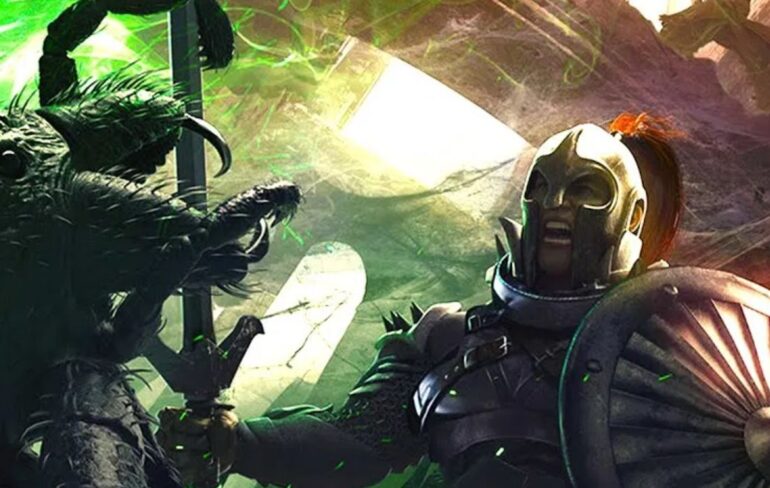
The tactical turn-based RPG genre is filled to the brim with iconic inspiration. From the pre-Bethesda Fallout titles to the early access release of Baldur’s Gate 3, the genre is home to a wealth of games many consider classics. Alongside these titans and other upcoming releases comes Solasta: Crown of the Magister, a more streamlined take on the genre.
You tackle the world of Solasta with a party of four characters who meet for the first time in an old tavern, summoned by the local magistrate to take on a secret mission. While you’re able to select from a few pre-made heroes, the game will encourage you to make your own before you start. The tutorial is neatly baked into the introductions between your party members, with dialogue that evokes the immersive flavor of a first D&D session with your friends.
Each member of your party is fully voiced with their own personalities, which play off of the character creation in a big way, taking into account your alignment and various other traits if they’re relevant to the storyline. They can also offer points of contention between characters, with certain traits appealing to different types of characters. Traits not relevant to the campaign at hand may be chosen for roleplaying purposes, but are easy to avoid because they are flagged during character creation. This makes creating a well-rounded party easy while naturally minimizing obvious flaws. It’s a very useful guide, as you’ll be controlling your entire party in this D&D inspired world.
The world of Solasta uses the popular Dungeons and Dragons 5th Edition ruleset, complete with dice rolls and skill charts, giving you plenty of options for character customization. While cosmetic options may be limited and generally superficial, the depth is in the details. Everything from your race and character class to your background matters in this high fantasy world and goes beyond the traditional number crunch associated with other titles in the genre. Races, classes and backgrounds come with perks that affect both combat and roleplaying interactions, altering rolls and opening extra dialogue and exploration options. This feeling continues throughout the game, with different party compositions offering different gameplay experiences.
Spell-slinging Elven Rogues can make for powerful DPS machines, while the traditional sword-and-board Dwarf Fighter makes a fine choice for those seeking a straightforward character build. These options make experimenting with different party compositions fun and gives replaying the game on higher difficulties an enticing quality once you understand the systems and the potential of the characters you can create.
Combat is engaging and flows well, using the fan-favorite D&D systems to simulate dice rolls for attacks and spells. Your progression will feel palpable throughout your journey, with plenty of options for growth and upgrades. Each class has a selection of different archetypes to keep things fresh and offer options that capitalize off of the wide variety of playable races available during character creation.
For those craving more creative activities, the game also offers an incredibly robust dungeon editor. Theme and tileset choices are admittedly on the small side, but this doesn’t make creating dungeons to test your characters any less addicting or fun thanks to the streamlined controls. Each selection has detailed tooltips, which makes finding the perfect parts to fill up your dungeon easy and fun. Everything from enemy encounters, to room placement, and even creating your own skill checks and lore entries feels easy to grasp after just the first few hours of experimentation. You’re even able to connect the “floors” you create with entrances and exits for epic multi-level experiences akin to those you’ll find in the main quest line, then share them online for others to enjoy. Or, you can just make epic battlegrounds to play with the robust turn-based combat system.
The storyline and characters of Solasta are all engaging and fun to interact with. From the party introductions during the tutorial to the mystery of the shape-shifting lizard people who haunt the land, the writing and pacing evokes the feeling of a friendly tabletop role-playing experience. Controlling your party is fun and fluid, with no pathing issues and quick dice rolls. Finding secret doors, leaping over obstacles and opening treasure chests doesn’t require any shifting through menus to keep you immersed in the fantasy world. While the gameplay is smooth, the story hooks are fun and the dialogue can be delightfully robust and campy, Solasta isn’t exactly a perfect experience.
While smooth and responsive gameplay back up the solid narrative, the presentation leaves a lot to be desired. It’s not an exaggeration to say this game looks like it came from the Xbox 360 era at times, with stretched textures and in-your-face polygonal graphics. There are also awkward quirks during cutscenes, such as characters lurching forward and creeping over to their destinations instead of moving upright as they do during gameplay. These elements are comical at first, but can serve to take you out of the moment, undermining the engaging aspects of the storytelling. These can especially sting when the cheeky dialogue falls flat or begins to awkwardly trail off. Since these issues are mostly nonexistent during gameplay and combat due to the top-down perspective, it can be jarring to enter cutscenes and see just how ugly it all is.
Solasta: Crown of the Magister is a fun tactical turn-based experience that focuses on tight gameplay to tie together the fun narrative. Character creation is robust and interesting to experiment with, giving you a great feeling of satisfaction when you see your team in action and how your choices play out. While the visuals may feel dated, the story and dialogue does a fine job of evoking the friendly atmosphere of a tabletop session of Dungeons and Dragons. The excellent dungeon editor is easy to use and understand, offering even more replayability. For those looking for a more gameplay-focused take on the tactical turn-based RPG, this game is not to be missed.
A PC key was provided by PR for the purposes of this review.
VERDICT
While Solasta: Crown of the Magister suffers from lackluster visual presentation, the tight gameplay and excellent dungeon editor make this a game that fans of the genre won’t want to miss.
7.5
Metacritic score starts out at 77: https://www.metacritic.com/game/pc/solasta-crown-of-the-magister
















